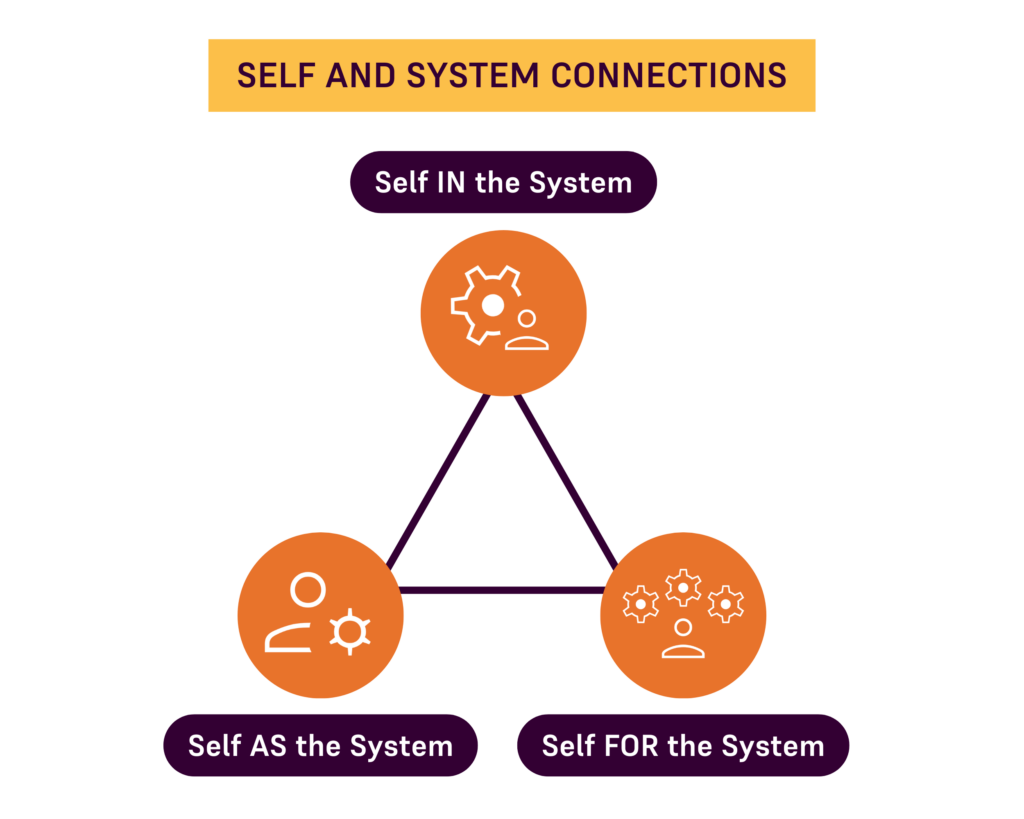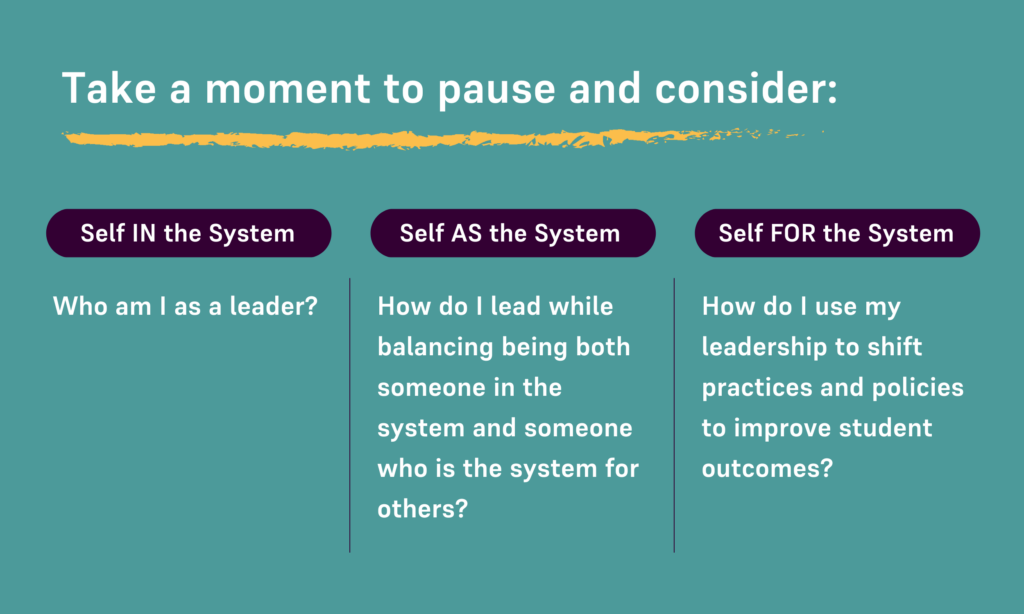
By Doe Kim, Program Design Director
In today’s challenging educational environment, you may be simultaneously grappling with addressing unfinished instruction, staff shortages, chronic absenteeism, and the pressure to meet diverse student needs.
Amidst this chaos, when do you find the time to pause and (re)assess decisions you’ve made and implemented? How do you recalibrate your leadership compass and ensure you’re on the right path?
In such high-pressure moments, it might seem impossible to hit the brakes. Yet, it’s precisely in these chaotic times that taking a step back becomes essential. Leadership effectiveness and transformational change hinge on the ability to reflect on oneself and your educational system. Self-analysis and system analysis are vital tools that help navigate the complexities of educational leadership.
The Leader’s Formula for Change

This model underscores the relationship between personal reflection, systemic understanding, and the collective power of a unified team. By embracing this formula, leaders can drive transformational change within their educational environments.
Self-Analysis: Checking the Rearview Mirror and Fuel Levels
You’ve likely heard of “self-reflection” as a key lever for personal growth and development. Self-reflective leaders are more adept at navigating complex educational landscapes (Macias, 2024). This leads to our desired goal: improved outcomes for both teachers and students. John Hattie’s research emphasizes that self-reflection enhances collective efficacy — the shared belief in the group’s ability to achieve goals and overcome challenges (Donahoo et al., 2018). Collective efficacy is one of the most powerful influences on student achievement (Visible Learning, 2018).
I prefer to call it self-analysis, not self-reflection. Analysis implies a more thorough and critical look at your actions and their impact. Self-analysis goes beyond mere reflection. It encourages active evaluation of your beliefs, knowledge, and behaviors and prompts you to consider how these elements shape your leadership style and effectiveness.
The Importance of Self-Analysis
Self-analysis is like regularly checking your rearview mirror and fuel levels while driving. It allows you to monitor your past actions, understand your current state, and prepare for future journeys. When you pause to reflect and realign with your leadership goals, you can better adapt to new situations. You can focus on the big picture and make conscious, healthy decisions.

Now that you’ve considered these personal insights, it’s time to broaden the scope. Just as self-analysis reveals personal actions and motivations, system analysis shows how these individual elements fit within your larger educational context.
System Analysis: The Map for the Educational Journey
The Importance of System Analysis
In education, system analysis involves examining the broader context and environment. It’s about understanding your situation within it, much like using a map for navigation. This multifaceted approach is critical for effective leadership. You can’t fix what you don’t see or understand.
System analysis helps you identify systemic barriers and enables you to see how individual actions influence the system. Once you know this, you can implement strategies that promote equity and improve student outcomes. This analysis provides your map for informed decision-making. It ensures that your leadership efforts align with your district or school’s overarching goals.

Components of a System Analysis
| Self IN the System | Self AS the System | Self FOR the System |
|---|---|---|
| First, acknowledge how your actions influence your educational system. Every decision creates a ripple effect across the system. Understand your impact on students, teachers, and school culture. For example, your commitment to professional development can inspire teachers to pursue continuous learning. Teachers’ continuous learning improves instructional practices and student outcomes. | Next, balance your dual roles. You are an individual within the system and its representative. You must navigate personal responsibilities while embodying the institution's values and goals. This means growing professionally while supporting and guiding your team. Be both a participant in and an advocate for the system. Ensure your leadership aligns with the broader objectives of the school or district. | Finally, commit to identifying and addressing barriers that hinder success. Map the path around or through these barriers. Help others navigate within the broader system. Advocating for systemic changes to promote equity and improve student outcomes is essential. Use your influence to support equitable policies, inclusive practices, and high academic standards. Doing so might involve pushing for better resource allocation, diverse hiring practices, or inclusive curriculum changes. |

Collective Efficacy: The Engine Driving Transformational Change
Collective efficacy is the powerful engine driving transformational change in education.
Pausing to reflect on oneself and the system is essential for building stronger teams. Trusting teams is a foundation for collective efficacy. Team members must trust one another enough to engage in self-analysis with vulnerability. Then, through system analysis, they can seek to understand their contributions and see their impact on the broader goals. When everyone understands their roles and the effects of their actions in the shared educational context, it promotes mutual support and collaboration. As each member’s actions align with the broader objectives, it enhances collective efficacy.
When you and your team align your efforts with the principles of self- and system analysis, you create a unified approach. This unified approach improves student outcomes and drives meaningful, systemic change throughout your educational community.

I want to focus on collective efficacy within our school and identify motivations to reach a common goal that centers student outcomes rather than strictly working on academic tasks.
2023 Leadership Institute ParticipantSo What? Now What?
Integrating self-analysis and system analysis is crucial for actualizing the change you seek. These practices:
- Reground yourself in your priorities
- Foster collective efficacy between you and your “first team,” and
- Drive systemic improvements.
Yet, many of us often feel that we can’t step away from the daily happenings in our schools to take this necessary pause.
UnboundEd’s three-day Leadership Institute provides the time and space for leadership teams to come together, analyze, strategize, and align efforts. Leadership Institute offers the framework and support needed for these transformative practices. By pausing and reflecting, you can lead your educational community toward greater success and resilience, ensuring meaningful and lasting educational change.
References
Donahoo, J., Hattie, J., & Eells, R. (2018). The Power of Collective Efficacy. ASCD. https://www.ascd.org/el/articles/the-power-of-collective-efficacy
Macias, O. (2024, June 3). The importance of self-reflection and self-care for school and district administrators during the summer. Association of California School Administrators. https://content.acsa.org/the-importance-of-self-reflection-and-self-care-for-school-and-district-administrators-during-the-summer/
Visible Learning. (2018). Collective teacher efficacy (CTE), according to John Hattie. Visible Learning. https://visible-learning.org/2018/03/collective-teacher-efficacy-hattie/
Next steps with GLEAM®
Choose the path that fits your team


UnboundEd Summits
Accelerate your instructional vision and build educators’ skills and expertise with a virtual or on-site Local Summit.
Learn More ➜

In-Service Workshops
UnboundEd’s dynamic, hands-on workshops build educator capacity by focusing on timeless, cross-disciplinary instructional moves that drive effective instruction, rigor, and student empowerment.
Learn More ➜
Online Math Academy
UnboundEd’s Online Math Academy courses enrich educators’ content knowledge and instructional practices to unlock all students’ math potential.
Learn More ➜
Curriculum Adoption
Ensuring quality materials are adopted and used effectively is crucial to improving outcomes and requires a strong instructional materials selection process. We’re here to share guidance and support on leading a rigorous and collaborative curriculum adoption process to select the right materials for your context and goals.
Learn More ➜
Curriculum Implementation
Just getting started, or need to get back on track? We work with you on a shared vision and an actionable plan for curriculum success.
Learn More ➜
Literacy ReclaimEd
Improve literacy instruction and better meet the unique needs of every student.
Learn More ➜
GLEAM® Inventory
Build your team’s understanding of grade-level, engaging, affirming, and meaningful –GLEAM®– instruction and transform how you serve all students in your district.
Learn More ➜
Speaking Engagements
Our experts offer inspiring, thought-provoking messages and conversations that will get your team thinking creatively about shifting mindsets and changing practice.
Learn More ➜
California Math Curriculum Adoption and Launch Cohort
Prepare to adopt and launch high-quality mathematics instructional materials with no-cost, grant-funded support from UnboundEd.
Learn More ➜